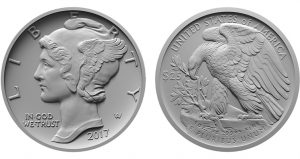As part of the lame duck session following the 2010 midterm elections, Congress passed the American Eagle Palladium Bullion Coin Act of 2010 (Pub. L. 111-303) telling the U.S. Mint strike one-ounce .9995 fine palladium bullion coins as part of the American Eagle Bullion Program. The coin will have a $25 face value and require that “the obverse shall bear a high-relief likeness of the ‘Winged Liberty’ design used on the obverse of the so-called ‘Mercury dime’” making it yet another bullion coin that will feature a design from the early 20th century. For the reverse, the law says that the coin “shall bear a high-relief version of the reverse design of the 1907 American Institute of Architects medal.” Both the Mercury Dime and 1907 AIA medal designed by Adolph A. Weinman, whose Walking Liberty design is used on the American Silver Eagle coins.
The catch to the law was that the U.S. Mint was to perform a feasibility study to determine if there will be market demand. Although the study showed that there is a market for palladium coins, it was not overwhelming. Based on the wording of the law, the U.S. Mint opted not to strike palladium coins.
This did not sit well with Rep. Dennis “Denny” Rehberg (R), Montana’s only member of the House of Representatives since the primary source of palladium in the United States is the Stillwater Mine in Montana. The mines, which also provides the U.S. supply of platinum group metals (PGM), is owned and operated by the Stillwater Mining Company. Rehberg added an amendment to the Fixing America’s Surface Transportation Act or the FAST Act (Public Law 114-94, 129 STAT. 1875, see Title LXXXIII, Sect. 73001) that took away the U.S. Mint’s option and added the word “shall.”
The FAST Act was also the law where the law was changed to allow the U.S. Mint to use better than 90-percent gold and silver in commemorative coins by changing the wording to say “not less than 90 percent….”
Palladium Eagle coins may have roughly the same impact on the market as the Platinum eagles since palladium is about $100 less expensive than platinum, 69-percent of the price of gold, but 53-times the price of silver. Based on the way the U.S. Mint prices precious metal products, the Palladium Eagle should cost within $100 of the platinum coins.
Although palladium is only the fourth metal to have an official ISO currency code (XPD), it is not readily thought of as a precious metal that is used to hedge against financial disaster. Gold (XAU) and silver (XAG) are usually thought of first. Sometimes, platinum (XPT) is part of the discussion, but not as frequently as gold or silver.
Palladium does have industrial uses. Because of its ability to absorb hydrogen and compounds with hydrogen, like hydrocarbon, its major use is in catalytic converters used in every gasoline powered vehicle. It is also seen as a key element in the potential of cold fusion because of its ability to absorb hydrogen.
It is likely the American Palladium Eagle will be as popular as the Platinum Eagle. Maybe the U.S. Mint will sell more of these coins because they will be slightly cheaper and have a design more appealing to collectors, but neither of these coins will approach the sales totals of the gold or silver version of the American Eagle coins.
It is not a coin I am likely to collect. However, I will probably purchase the 2017 coin to have one from the first year of issue just as I did with the 2007 American Buffalo 24-karat Gold Proof coin.



